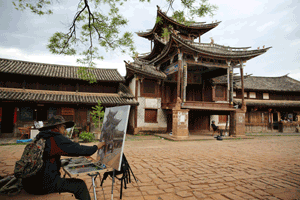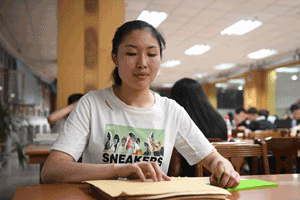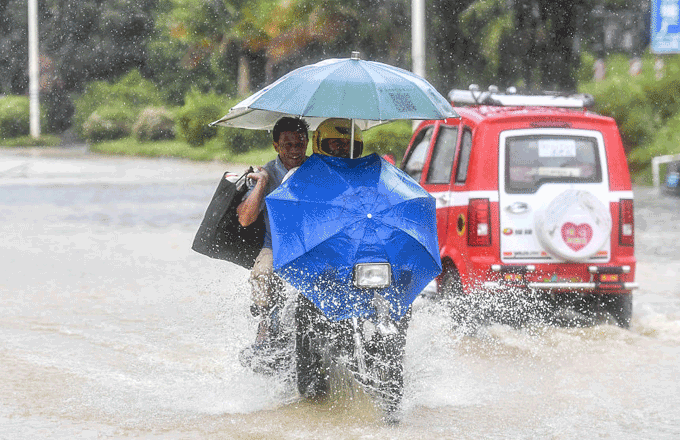Tourism - bouncing back from the trough
 |
|
The Hong Kong Tourism Board is going the extra mile to see that the “Pearl of the Orient” continues to glow, with tourism having taken a beating for more than a year. Future resources will be concentrated on luring more high-yield overnight tourists and diversifying tourism products by offering night tours, arts and cultural tours, as well as green tourism. [Jerome Favre / Bloomberg] |
Hong Kong's pummeled tourism business may have seen light at the end of the tunnel after more than a year in the doldrums, following the most spectacular growth recorded since the handover.
The industry's exponential buildup in the past two decades saw it emerge as the fastest growth pillar of the local economy, triggered by the explosive arrival numbers of Chinese mainland visitors cashing in on an unprecedented easing of curbs on individual travel to the SAR.
While the mainland visitor boom is not seen as a flash in the pan, the Hong Kong Tourism Board (HKTB) - created in 2011 and tasked with propelling the city into the ranks of the world's most preferred travel spots - has warned against complacency, and is going to great lengths to breathe new life into the sector with a multi-pronged approach that would lay stress on big-spending tourists, as well as cruise and green tourism.
The number of mainland tourist arrivals in Hong Kong ballooned to 42.77 million last year - a whopping 17-fold ascent from 2.36 million in 1997 - according to the HKTB, and mainland visitors still account for up to 76 percent of total tourist arrivals.
The watershed came in January 2002 when the central government scrapped the quota under the Hong Kong Tour Group Scheme of Mainland Visitors in a bold attempt to revive the SAR's economy following the Severe Acute Respiratory Syndrome outbreak.
The Individual Visit Scheme, which allows residents of designated mainland cities to visit Hong Kong as independent travelers without joining group tours, has been gradually extended since mid-2003 and now covers 49 cities.
The travel relaxation provided the much sought impetus for local tourism, making it the fastest growth pedestal of the city's gross domestic product (GDP).
The sector which, at one time was near the bottom of the GDP contributors list, made a stunning turnaround to outperform three traditional economic mainstays - financial services, trading and logistics, and professional and producer services - by growing 161 percent between 2002 and 2012, according to a research report by the Legislative Council Secretariat in February 2015.
The number of people working in the tourism field also went sky-high, surging 76 percent during the same period.
Tourism accounted for 2.9 percent of Hong Kong's GDP in 2002 in terms of value added, before hitting 5 percent in 2015, according to the Census and Statistics Department.
 |
|
Hong Kong Disneyland Resort remains a key attraction for tourists and has lined up an ambitious expansion plan to keep itself in the race with the region’s competitors. The city’s tourism business is in urgent need of a turnaround by strengthening its tourist handling capacity and luring more visitors with deep pockets, as well as upgrading conference and exhibition facilities. [Justin Chin / Bloomberg] |
In addition, travel was the largest component of the SAR's services exports, making up 34.6 percent of the value of total services exports in 2015, while net exports of travel contributed HK$101.5 billion to the city's overall invisible trade surplus in the same year.
The tourism trade hit the buffers in 2015 as the global and mainland economies beat a hasty retreat. It heralded the start of a downward correction as mainland visitor arrivals began to falter. Total visitor arrivals had dipped a further 4.5 percent last year after having sunk 2.5 percent in 2015.
The downturn was marked by crumpling retail sales - giving up 0.2 percent in 2014, and accelerated with falls of 3.7 percent and 8.1 percent, respectively, in 2015 and 2016.
The negative factors were pinned down as a decelerating mainland economy, mainland travelers' changing spending habits, growing competition from other tourism markets, as well as Hong Kong's over-stretched tourist handling capacity and the dearth of new local attractions.
A silver lining emerged early this year as total visitor arrivals crept back in the first quarter with a 3.7-percent, year-on-year increase after dropping 4.5 percent in 2016. The number of mainland visitors was up 3.8 percent year-on-year after having shrunk 6.7 percent last year, according to the HKTB.
" Exports of travel services also saw further relative improvement, reflecting the continued recovery in visitor arrivals. However, tourist spending has yet to resume growth, probably having been constrained by currency movements and changing tourist spending patterns," acting government economist Andrew Au Sik-hung said as he divulged Hong Kong's first quarterly economic growth data in May.
" Service exports are not that impressive as this part of external demand is mostly related to spending by mainland visitors," Daiwa Capital Markets remarked.
According to the Tourism Commission, total tourism expenditure associated with inbound tourism amounted to HK$296 billion in 2016 - a drop of 10.1 percent year-on-year.
The HKTB said it will have to revise its business promotion strategies from this year.
" The development of Hong Kong's tourism should not focus merely on achieving growth in visitor arrivals, but on pursuing balanced, healthy and long-term growth by developing diversified products and high-yield tourism," the Tourism Commission told the Legislative Council's panel on economic development in February.
Resources will be concentrated on driving more high-yield overnight tourist arrivals, promoting MICE (meetings, incentives, conferences and exhibitions) tourism and cruise tourism, and diversifying tourism products by offering night tours, arts and cultural tours, as well as green tourism.
The HKTB, however, warned that despite all the proposed undertakings, tourism may yet not recover from its trough.
It still expects total visitor arrivals to fall by 2.2 percent to 55.38 million this year, with mainland visitor numbers down 3.7 percent to 41.18 million, and total expenditure from inbound tourism to shed 4.6 percent to HK$287 billion.
oswald@chinadailyhk.com

























